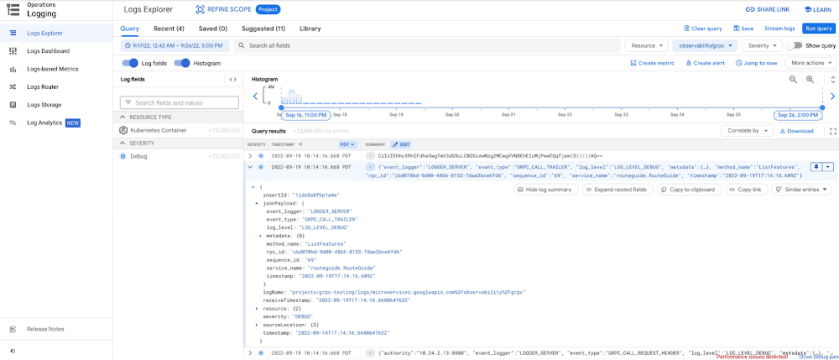The kinds of observability data provided
gRPC observability provides three different types of data:
1. Logs for key RPC events, including:
- When the client/server sends or receives the metadata of an RPC
- When the client/server sends or receives the message payload of an RPC
- When the client/server finishes an RPC with a final status (OK, or errors)
2. Metrics (or statistical data) for key RPC events, including:
- How many bytes the client/server sent or received
- How many RPCs the client/server started or completed
- How long RPCs take to complete between the client and server (known as round trip latency)
3. Distributed traces for RPCs and their fanout RPCs across the system. For example, when serving an RPC from upstream, a server may need to create multiple RPCs to its own backends. The distributed trace helps the user understand the relationships between these RPCs, the latency for each of them, and key events happening throughout the system.
How the observability data is produced and collected
When developers enable the gRPC observability feature in their binaries, the gRPC library will report the logging, metrics, and tracing data to Google Cloud’s operations suite. Once the observability data is collected, users can leverage the Google Cloud console to:
- Visualize the observability data
- Export the observability data out of the operations tools for further analysis with other tools.
Logging
gRPC observability provides logs for key RPC events with information to help developers understand the context when these events occur. This contextual information can include which gRPC service/method is being invoked, whether the events happen on the client side or server side, whether it’s sending metadata or payloads, the size of the corresponding data, and even the concrete content of the metadata and/or payloads. These log entries are then presented in Cloud Logging with helpers to filter and even customize the query to search related logs.

- 【High Speed RAM And Enormous Space】16GB DDR4...
- 【Processor】Intel Celeron J4025 processor (2...
- 【Display】21.5" diagonal FHD VA ZBD anti-glare...
- 【Tech Specs】2 x SuperSpeed USB Type-A 5Gbps...
- 【Authorized KKE Mousepad】Include KKE Mousepad
- 【EFFICIENT PERFORMANCE】ACEMAGIC Laptop...
- 【16GB RAM & 512GB ROM】Featuring 16GB of DDR4...
- 【15.6" IMMERSIVE VISUALS】This 15.6 inch laptop...
- 【NO LATENCY CONNECTION】The laptop computer...
- 【ACEMAGIC CARE FOR YOU】 This slim laptop will...
Metrics
gRPC observability provides several metrics: the round trip latency of RPCs, how many RPCs were started and finished during a specific period of time, and even the number of bytes sent/received over the wire. All these metrics can be grouped by a few important parameters, including service/method name and final status. Platform-specific metrics can be included as well, depending on the Google Cloud environment and the gRPC payload actually running. For example, on the Google Kubernetes Engine (GKE) platform, developers can group/filter by namespace, container, and pod information fields to dig into more granular statistical data. With these metrics, Cloud Monitoring enables users to identify problems including:
- Which container is having higher than normal latency
- Which pod is having higher than normal error rates
- And others.

Tracing
gRPC observability also allows developers to configure the sampling rate of RPCs. The sampling decision is propagated across the whole system, thus no matter where the RPCs actually happen, developers can always see a complete, end-to-end distributed trace for their processing logic. Sampled RPCs and any further RPCs triggered by them are displayed in Cloud Trace as parent/children spans.

Getting started
With gRPC observability, telemetry data (logs, metrics, traces) of gRPC workloads can be collected and reported to the Google Cloud operations suite. It helps developers get a better understanding of their systems and enables them to diagnose problems such as:
- Which microservices have suddenly become abnormally slow (long processing latency on the server side)?
- Which microservices suddenly process less QPS, and is there a pattern?
- Whether there’s a potential network issue for a particular microservice, as high latency is measured on the client side, but normal latency on the server side? If so, can we locate the problem in a particular cluster, or even a particular node/pod?
- [High Speed RAM And Enormous Space] 64GB...
- [Processor] Intel Core i7-13700 (16 Cores, 24...
- [Tech Specs] 1 x USB 3.2 Type-C, 4 x USB 3.2...
- [Operating System] Windows 11 Home - Beautiful,...
- AMD Ryzen 5 3600 6-Core 3.6 GHz (4.2 GHz Turbo)...
- GeForce RTX 3060 12GB GDDR6 Graphics Card (Brand...
- 802.11AC | No Bloatware | Graphic output options...
- Heatsink & 3 x RGB Fans | Powered by 80 Plus Gold...
- 1 Year Warranty on Parts and Labor | Lifetime Free...
- 【Excellent performance】 Laptop is equipped...
- 【Do Your Tasks Easily】 Laptop computer comes...
- 【Amazing Visuals】 The 17.3-inch laptop...
- 【Poweful Cooling System】Laptops are equipped...
- 【External Ports Design】Notebook computer comes...
To get started with gRPC observability, see our user guide.






